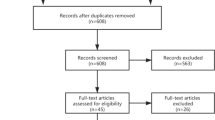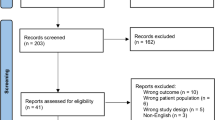Abstract
Purpose
With an increasing number of total knee arthroplasty (TKA), protocols for better standard of patient care and shorter duration of hospital stay are necessary. Enhanced recovery (ER) protocols are becoming popular to meet these objectives. The current study aims to evaluate the clinical outcome of fast-track TKA using ER protocol in terms of length of hospital stay, perioperative complications and functional outcomes.
Methods
Patients undergoing single-stage bilateral primary TKA were prospectively included in the study. All patients went through a pre-defined ER protocol of TKA. Length of hospital stay, readmission rates, pain scores and functional scores of patients operated under ER protocol were compared with another matched historical control-group. Factors delaying the discharge of the patients by 48 h after the surgery were noted.
Results
We compared 275 patients undergoing single-stage bilateral primary TKA through ER protocol (Group 1) with 190 patients who had undergone bilateral primary TKA before the ER protocol was initiated (Group 2). The length of hospital stay (3.9 ± 2.1 days in group 1 and 7.5 ± 3.2 days in group 2, p 0.0001) and post-operative pain scores at 12 h (5.2 ± 2.9 in group 1 and 5.7 ± 2.1 in group 2, p 0.03) and 24 h (4.1 ± 1.6 in group 1 and 4.6 ± 1.4 in group 2, p 0.0005) were found to be significantly better with ER protocol. There was no difference in Oxford knee scores, infection rates, readmissions or mortality between the two groups.
Conclusion
ER protocol in single-stage bilateral primary TKA resulted in decreased length of hospital stay without increasing complications and compromising the clinical outcome. It requires an integrated approach and adherence to clinical pathways.
Level of evidence
Level II, Prospective comparative study.
Similar content being viewed by others
References
McDonald DA, Siegmeth R, Deakin AH et al (2012) An enhanced recovery programme for primary total knee arthroplasty in the United Kingdom - follow up at one year. Knee 19:525–529. https://doi.org/10.1016/j.knee.2011.07.012
Malviya A, Martin K, Harper I et al (2011) Enhanced recovery program for hip and knee replacement reduces death rate: A study of 4,500 consecutive primary hip and knee replacements. Acta Orthop 82:577–581. https://doi.org/10.3109/17453674.2011.618911
Larsen K, Hvass KE, Hansen TB et al (2008) Effectiveness of accelerated perioperative care and rehabilitation intervention compared to current intervention after hip and knee arthroplasty. A before-after trial of 247 patients with a 3-month follow-up. BMC Musculoskelet Disord 9:59. https://doi.org/10.1186/1471-2474-9-59
Den Hertog A, Gliesche K, Timm J et al (2012) Pathway-controlled fast-track rehabilitation after total knee arthroplasty: a randomized prospective clinical study evaluating the recovery pattern, drug consumption, and length of stay. Arch Orthop Trauma Surg 132:1153–1163. https://doi.org/10.1007/s00402-012-1528-1
Scott NB, McDonald D, Campbell J et al (2013) The use of enhanced recovery after surgery (ERAS) principles in Scottish orthopaedic units—an implementation and follow-up at 1 year, 2010–2011: a report from the Musculoskeletal Audit, Scotland. Arch Orthop Trauma Surg 133:117–124. https://doi.org/10.1007/s00402-012-1619-z
Isaac D, Falode T, Liu P et al (2005) Accelerated rehabilitation after total knee replacement. Knee 12:346–350. https://doi.org/10.1016/j.knee.2004.11.007
Kumar L, Kumar AH, Grant SA, Gadsden J (2018) Updates in enhanced recovery pathways for total knee arthroplasty. Anesthesiol Clin 36:375–386. https://doi.org/10.1016/j.anclin.2018.04.007
Larsen K, Hansen TB, Søballe K, Kehlet H (2012) Patient-reported outcome after fast-track knee arthroplasty. Knee Surg Sport Traumatol Arthrosc 20:1128–1135. https://doi.org/10.1007/s00167-012-1919-4
Wind J, Polle SW, Fung Kon Jin PHP et al (2006) Systematic review of enhanced recovery programmes in colonic surgery. Br J Surg 93:800–809
Melnyk M, Casey RG, Black P, Koupparis AJ (2011) Enhanced recovery after surgery (eras) protocols: Time to change practice? J Can Urol Assoc 5:342–348
Middleton RM, Marfin AG, Alvand A, Price AJ (2018) Enhanced recovery programmes in knee arthroplasty: current concepts. J ISAKOS Jt Disord Orthop Sport Med 3:282–286. https://doi.org/10.1136/jisakos-2018-000218
Galbraith AS, McGloughlin E, Cashman J (2018) Enhanced recovery protocols in total joint arthroplasty: a review of the literature and their implementation. Ir J Med Sci 187:97–109. https://doi.org/10.1007/s11845-017-1641-9
Zhu S, Qian W, Jiang C et al (2017) Enhanced recovery after surgery for hip and knee arthroplasty: a systematic review and meta-analysis. Postgrad Med J 93:736–742. https://doi.org/10.1136/postgradmedj-2017-134991
Rutherford RW, Jennings JM, Dennis DA (2017) Enhancing recovery after total knee arthroplasty. Orthop Clin North Am 48:391–400. https://doi.org/10.1016/j.ocl.2017.05.002
Saunders P, Katam K, Young SK (2016) Five year review of an enhanced recovery program following knee arthroplasty at a UK general district hospital. Physiotherapy 102:e64–e65. https://doi.org/10.1016/j.physio.2016.10.389
Nagra NS, Hamilton TW, Strickland L et al (2017) Enhanced recovery programmes for lower limb arthroplasty in the UK. Ann R Coll Surg Engl 99:631–636. https://doi.org/10.1308/rcsann.2017.0124
Kehlet H (2017) Enhanced recovery after surgery for hip and knee arthroplasty: Where is the evidence? Br J Anaesth 118:628. https://doi.org/10.1093/bja/aex058
Stambough JB, Nunley RM, Curry MC et al (2015) Rapid recovery protocols for primary total hip arthroplasty can safely reduce length of stay without increasing readmissions. J Arthroplasty 30:521–526. https://doi.org/10.1016/j.arth.2015.01.023
Crawford LA, Hart W (2008) Factors affecting length of stay following total joint replacement. Orthop Proc 90B:546
Husted H, Holm G, Jacobsen S (2008) Predictors of length of stay and patient satisfaction after hip and knee replacement surgery: Fast-track experience in 712 patients. Acta Orthop 79:168–173. https://doi.org/10.1080/17453670710014941
Vingerhoeds B, Fick D, Middleton R, et al (2010) A patient-centred pathway dramatically reduces length of stay and improves outcomes in primary joint replacement in a safe way. Orthop Proc 92B:500
Jørgensen CC, Kehlet H (2013) Role of patient characteristics for fast-track hip and knee arthroplasty. Br J Anaesth 110:972–980. https://doi.org/10.1093/bja/aes505
Krenk L, Jennum P, Kehlet H (2013) Activity, sleep and cognition after fast-track hip or knee arthroplasty. J Arthroplasty 28:1265–1269. https://doi.org/10.1016/j.arth.2013.02.013
Fuzier R, Serres I, Bourrel R et al (2014) Analgesic drug consumption increases after knee arthroplasty: a pharmacoepidemiological study investigating postoperative pain. Pain 155:1339–1345. https://doi.org/10.1016/j.pain.2014.04.010
Beswick AD, Wylde V, Gooberman-Hill R et al (2012) What proportion of patients report long-term pain after total hip or knee replacement for osteoarthritis? A systematic review of Prospective studies in unselected patients. BMJ Open 2(1):e000435
Courtney PM, Boniello AJ, Berger RA (2017) Complications following outpatient total joint arthroplasty: an analysis of a national database. J Arthroplasty 32:1426–1430. https://doi.org/10.1016/j.arth.2016.11.055
Lovald S, Ong K, Lau E et al (2014) Patient selection in outpatient and short-stay total knee arthroplasty. J Surg Orthop Adv 23:2–8. https://doi.org/10.3113/JSOA.2014.0002
Kehlet H, Thienpont E (2013) Fast-track knee arthroplasty—status and future challenges. Knee 20:S29
Berend ME, Berend KR, Lombardi AV (2014) Advances in pain management: Game changers in knee arthroplasty. Bone Jt J 96B:7–9
Azam MQ, Sadat-Ali M, Badar A (2016) Pain management in knee arthroplasty: an overview. Curr Orthop Pract 27:360–370
Auyong DB, Allen CJ, Pahang JA et al (2015) Reduced length of hospitalization in primary total knee arthroplasty patients using an updated enhanced recovery after orthopedic surgery (ERAS) pathway. J Arthroplasty 30:1705–1709. https://doi.org/10.1016/j.arth.2015.05.007
Klement MR, Bullock WM, Nickel BT et al (2019) Continuous adductor canal blockade facilitates increased home discharge and decreased opioid consumption after total knee arthroplasty. Knee 26:679–686. https://doi.org/10.1016/j.knee.2019.01.020
Wang D, Yang Y, Li Q et al (2017) Adductor canal block versus femoral nerve block for total knee arthroplasty: a meta-Analysis of randomized controlled trials. Sci Rep 7:1–13. https://doi.org/10.1038/srep40721
Bjerregaard LS, Bagi P, Kehlet H (2014) Postoperative urinary retention (POUR) in fast-track total hip and knee arthroplasty. Acta Orthop 85:8–10
Ma Y, Lu X (2019) Indwelling catheter can increase postoperative urinary tract infection and may not be required in total joint arthroplasty: A meta-analysis of randomized controlled trial. BMC Musculoskelet Disord 20:11. https://doi.org/10.1186/s12891-018-2395-x
Wang HY, Wang L, Luo ZY et al (2019) Intravenous and subsequent long-term oral tranexamic acid in enhanced-recovery primary total knee arthroplasty without the application of a tourniquet: A randomized placebo-controlled trial. BMC Musculoskelet Disord 20:478. https://doi.org/10.1186/s12891-019-2885-5
Hausel J, Nygren J, Thorell A et al (2005) Randomized clinical trial of the effects of oral preoperative carbohydrates on postoperative nausea and vomiting after laparoscopic cholecystectomy. Br J Surg 92:415–421. https://doi.org/10.1002/bjs.4901
Guerra ML, Singh PJ, Taylor NF (2015) Early mobilization of patients who have had a hip or knee joint replacement reduces length of stay in hospital: A systematic review. Clin Rehabil 29:844–854
Funding
There is no funding source.
Author information
Authors and Affiliations
Corresponding author
Ethics declarations
Conflict of interest
The authors declare that they have no conflict of interest.
Ethical approval
The institutional ethics committee approved the study (AIIMS/IEC/18/163).
Informed consent
Informed consent was obtained from all individual participants included in the study.
Author's Contribution
Each author certifies that he or she has no commercial associations (eg, consultancies, stock ownership, equity interest, patent/licensing arrangements, etc) that might pose a conflict of interest in connection with the submitted article. Dr. Md. Quamar Azam: the conception and design of the study, Dr Tarun Goyal: the conception and design of the study, drafting the article or revising it critically for important intellectual content, final approval of the version to be submitted, Dr Souvik paul: interpretation of data, drafting the article or revising it critically for important intellectual content, Dr Arvind kumar Yadav: the acquisition of data, Dr. Nishith Govil: the conception of the study, The study was conducted in All India Institute of Medical Sciences, Rishikesh, India.
Additional information
Publisher's Note
Springer Nature remains neutral with regard to jurisdictional claims in published maps and institutional affiliations.
Rights and permissions
About this article
Cite this article
Azam, M.Q., Goyal, T., Paul, S. et al. Enhanced recovery protocol after single-stage bilateral primary total knee arthroplasty decreases duration of hospital stay without increasing complication rates. Eur J Orthop Surg Traumatol 32, 711–717 (2022). https://doi.org/10.1007/s00590-021-03031-y
Received:
Accepted:
Published:
Issue Date:
DOI: https://doi.org/10.1007/s00590-021-03031-y




